
CHART
BOX
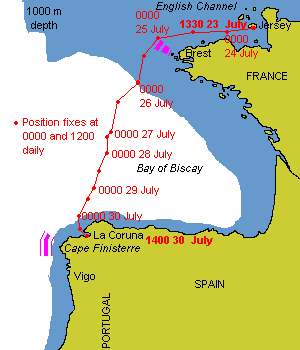
© Copyright 1999 Nigel Jones/MistWeb Software

A year ago, when I had first fitted our Raytheon 'Pathfinder' Radar, I stayed on board until late while I got it all wired up ready for a test. (Click here for details of this job, and of the unit itself). I was on our drying berth in St Helier Old Harbour, Jersey. When I first got an image on the screen it was of the harbour itself. I was disappointed, "All that money and it's not even linear," I thought. The image clearly showed harbour walls tapering together in front of me when, since I was a child, I'd known the harbour basin to be rectangular. I tried a longer range and saw little but a vague smudge to the South-West. "There's nothing out there," I thought, "unless it's so good it's picking up the Minquiers." The Minquiers (pronounced: Minkies) are a dangerous, rocky reef about 10 - 15 miles South of Jersey. I decided to get out a chart to check their range and bearing to see if the unit was any better at long-distances. The first thing I noticed was that, on the chart, the Old Harbour basin is not rectangular at all, but tapers exactly like the radar image showed. Well, that was very good but it was doing very badly with the Minquiers. It had the range and direction seriously wrong. I decided to double-check. Worse! It was still wrong and it had moved the image! "Oh, everything drifts as it warms up!" I watched the radar target drift slowly towards the boat over the next 20 minutes. I was feeling seriously disappointed. When I decided to give up and go home, I was met by the first few spots of a serious down-pour outside the hatch. "Of course!! That was never the Minquiers on the screen, but this approaching rain-cloud, being perfectly tracked by a very good and accurate system!" I went home very happily in that rain.
 |
CHART |

|
|
| Sketch Maps and Chartlets (not to be used for navigation!) © Copyright 1999 Nigel Jones/MistWeb Software |
|
At 2000 on Monday 26th July we would have felt a little foolish if there had been anyone else 140 NM (nautical miles) from land to see us: We were reefed down for winds of Force 6 or more, wearing our yankee jib, a storm stays'l and the first reef in the main, and there was hardly any wind at all. Our speed had dropped to 2 knots. But the barometer was down to 1005 mb and had been dropping for the last three days from a high of 1021 mb on the Friday night. It was getting dark and it was better to be safe than sorry. Getting caught with too much sail up in the middle of the night in the middle of nowhere in Biscay had caused serious gear breakage and sail-shredding on a tall ship a friend of mine had once crossed in.
By midnight we had had a tantalising hint of some wind but it had gone again. We decided to put the engine on at 0030 and it was pleasant to be making progress again. I edged the throttle open to push our speed up from five knots to six. After a while your mind blanks out the noise of the diesel and it is not too troublesome.
At 0115, without warning or ceremony, the engine stopped. It went from full throat to silence in the time of one ignition. "Something big in the prop!" I thought and pulled open the interior engine casing, hoping that the damage did not include a torn-out propshaft, broken fibreglass or anything else that would be letting in water. Everything looked perfect, as it always did. No visible damage at all, just a warm engine, stopped, and a perfect propshaft, also stopped.
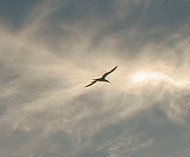 |
| This was one of the birds that accompanied the pilot whales, described on the previous page. There were many of them wheeling above the scene as the whales befriended us. |
I clipped on and climbed out into the cockpit to look over the back. Snaking behind, in the moonlight, I could see about 4 - 5 meters of pale green bulk trailing from the propeller. As I watched and my eyes learned to focus through the water surface, I could see that it was netting. Coarse, heavy fishing net.
Nicky had joined me and we both watched it for a while. The wind was down to a whisper and we began to consider our options. The first idea, to try to run the engine in reverse to see if it untangles, we rejected. It did no damage to our hull integrity when it arrived, but if we start messing with it under power, who knows what we might break?
The next idea of stripping off and getting down there with a knife was also soon scrapped. There was not much wind but this was the open ocean and there was still a lot of vertical movement between our transom and the water level. A serious bang on the head was not what either of us needed right now.
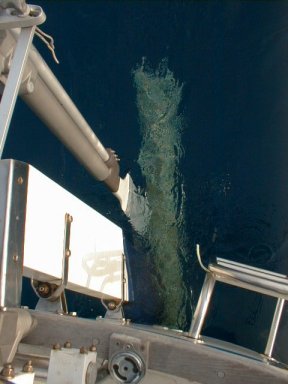 |
| This is the remains of the fishing net caught in our propeller, as seen the next morning after we had cut three-quarters of it off and bagged it up in the cockpit locker. You can see it is not inteferring too much with the power-paddle of the windvane steering - aft of the rudder. |
No, we were stuck with it until we got to Spain, but we realised we could minimise its drag if we hooked it with a boat-hook, dragged the bulk of it on board and then cut it as low down as we could reach over the transom. We set to work on this and by 0200 were filling a large black plastic sack with most of its stinking bulk. Hooked and tangled in it were all kinds of horrors including rotten, dead sea-birds. It must have been floating around out here for years. The sack and the entire set of clothes I had been wearing were all consigned to a cockpit locker where hopefully we could escape from the smell.
We still had about 2 m of net trailing behind but this was probably light enough that it would not interfere too much with the power-paddle on the windvane steering. In fact it did not. Hopefully it would not slow us down too much either, as we were now totally dependent on winds and sail. By 02:30 we had shaken out the reef and replaced the storm-stays'l with the normal one again. We were making 2 knots in very little wind.
By 0330 we had finished putting the second reef into the mainsail and replacing the storm-stays'l again. The Navtex had come up with the rather alarming forecast of "Thundersqualls with severe gusts" for our sea-area. At 0400 I found the nearest squall on the radar and I was tracking it. It was 8 NM to the North-East of us and coming our way. It may pass to the North of us, I wrote. You cannot be too certain of the course and speed of such an entity. It could grow in size as it travels, for one thing.
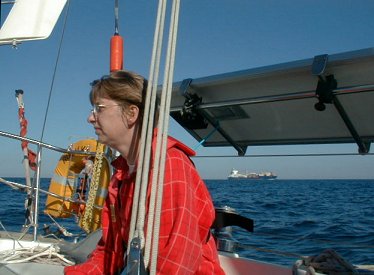 |
| Nicky looking tired as a deep-sea freighter steams past us. |
The air felt damp and the sea was getting agitated. We then had 7 knots of Westerly wind and 2½ knots of boat-speed to the South. I had us on a beam reach, under very little sail, trying to improve our point of closest approach as much as possible without an engine.
Half an hour later, at 0430, the storm, about 1 - 2 NM across, had passed our stern 5½ NM away. The wind had immediately veered by 90°. The storm looked very black and sounded like distant traffic-noise as it tracked across our transom. The sea was an active, hissing one-meter chop with sudden breakers appearing all over it at random. We never saw more than 8 knots of warm, wet and threatening wind. As soon as the wind had veered it started backing again and we were soon beam-reaching on our original course of 204° without my having to touch the sails or the windvane steering.
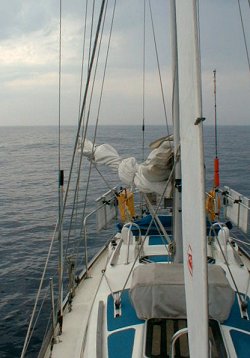 |
| At our furthest point from land during the crossing, we spent half a day becalmed and disabled with a fishing net around the propeller. Notice the sheeted-in storm staysail, my attempt to reduce our rolling while we awaited the return of some wind. |
As the storm cleared our North-East sector it was replaced by the first, grey light of the morning sun below the horizon. As it backed, the wind reduced to 3 - 5 knots, our speed dropped to 1.2 knots, and the barometer reached 1006 mb, starting to rise again.
At 0630 there was no wind at all but the swell was making the sails slat and bang terribly as we rolled, so we took them all down except for the heavy, flat storm stays'l, which I sheeted in hard amidships to try to dampen our rolling in the smooth, hilly seas. Nothing much changed until 1100 when we felt a few breaths of air from the South and had rested enough to feel like putting up the big genoa to see if it could steady the boat enough for it to get us moving.